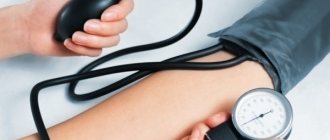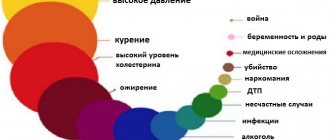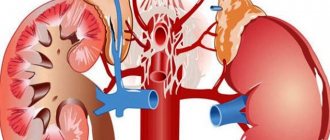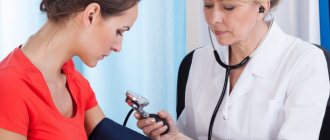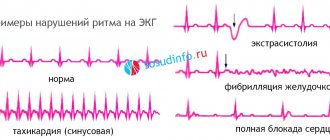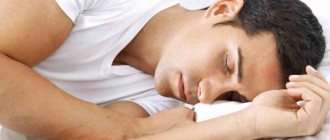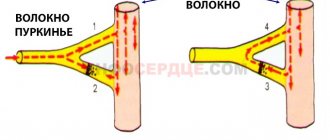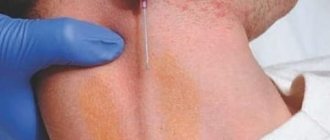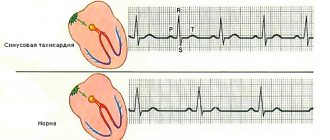When it comes to patients with hypertension, we usually imagine elderly people who are faced with this unpleasant disease due to the natural aging of the body. Unfortunately, hypertension also occurs in children. Its causes differ significantly between young and old people, but timely diagnosis and treatment are vital in any case.
Hypertension and its causes
1. Increased blood pressure due to endocrine diseases:
- excess thyroid hormones produced by the thyroid gland;
- adrenal tumor;
- Itsenko-Cushing syndrome;
- excess body weight;
- diabetes.
2. For kidney diseases:
- with congenital underdevelopment of the kidneys;
- kidney injuries;
- hydronephrosis is a congenital kidney disease in which the kidney begins to accumulate fluid;
- narrowing of the renal vessels or their blockage (thrombosis);
- tumors that produce hormones similar to kidney ones.
3. Taking medications:
- nasal drops with a vasoconstrictor effect for congestion;
- hormonal drugs, including contraceptives;
- anti-inflammatory non-hormonal drugs.
4. For vegetative-vascular dystonia in adolescents.
5. During menstruation, girls experience increased blood pressure.
6. For congenital heart defects (narrowing of the aorta).
Causes
The rise in pressure is the response that is created when a stressful situation occurs. As a result, hormones begin to be produced by the higher centers of the nervous system. They affect the vascular wall, which spasms. High levels of aldosterone lead to sodium and water retention in the body. Subsequently, fluid accumulates that would normally be excreted by the kidneys.
The amount of water in the vascular bed increases, this leads to an increase in pressure. Over a period of time, thickening of the blood, narrowing of the lumen in the vessels and thickening of their walls are noted. Such changes in the body lead to a persistent increase in vascular resistance. As a result, arterial hypertension becomes stable, and its condition already becomes irreversible. As the disease progresses, the walls of blood vessels become more permeable, which leads to the development of changes in various organs and tissues.
The causes of hypertension in childhood are:
- excess weight;
- wrong lifestyle;
- frequent stress;
- aggravating heredity;
- taking certain medications;
- chronic diseases.
Unlike adults, children do not suffer from atherosclerosis, and therefore it is not among the reasons for the development of hypertension. The main problem is excess weight and varying degrees of obesity. Every year, up to 20,000 new cases of overweight in children are recorded. Obesity develops at any age, but most often it is typical for urban girls aged 10-13 years.
In addition to this, many teenagers smoke and drink alcohol. A large amount of salty food also has a negative effect. Hypertension in children also appears with constant exposure to stress. The risk group most often includes those who have an excitable nervous system and an unbalanced psyche. In many cases among young men and adolescents, mood swings are associated with hormonal changes during puberty.
If there have already been cases of hypertension in the family among close relatives, then, with a high degree of probability, the child will develop the same thing. Under the influence of provoking factors, the disease can occur in adolescence. Heredity is especially strongly transmitted through the maternal line.
When treating with certain drugs, it is important to consider the side effects and the age at which they can be given to a child. Vasoconstrictor drops to relieve nasal congestion during a runny nose can increase blood pressure, which provokes the appearance of symptoms of hypertension.
After receiving a skull injury, some children experience pressure surges for a long time. In addition, chronic diseases are also taken into account. It is believed that sinusitis and caries can provoke symptoms of hypertension. Among kidney diseases, a negative effect on blood pressure is reflected in the presence of a history of glomerulonephritis and pyelonephritis. In case of pathology of the cardiovascular (aortic valve insufficiency, coarctation) and endocrine systems (Itsenko-Cushing's disease, pheochromocytoma), pressure must be measured. Most often in young patients it will be increased.
Rules for measuring blood pressure
Types of tonometers:
- manual;
- electronic;
- semi-electronic.
Personal experience! The choice of a tonometer is based on personal priorities. The disadvantages of electronic tonometers are that they are very sensitive and can distort the true values. Personally, I prefer completely manual blood pressure monitors.
Pressure measurements should be:
- in a warm room, in a comfortable environment;
- an hour after breakfast, coffee or tea, or better in the morning on an empty stomach;
- when the child is completely relaxed;
- in silence and with the correct body position (you cannot cross your legs, talk, laugh).
It is better to measure blood pressure while lying down, on both arms in turn. Ideally there should be three measurements on both hands. The difference between the right and left hand is normally about 5 - 10 mm. rt. Art.
Labile hypertension and military conscription
Many young people are concerned about the question of whether they are recruited into the army with labile arterial hypertension. The answer is to be found in Art. 43 “Schedules of illnesses.” The document was last updated in 2014.
The conscript undergoes a diagnosis of the disease - ABPM (24-hour blood pressure monitoring). It must be carried out not at home, but in a hospital. To be exempt from military service, the following indicators are required:
- upper pressure at rest: 140-159 mmHg and above;
- lower pressure at rest: 90-99 mmHg and above.
The conscript is released under clause B of Art. 43 “Schedules of Diseases”, is enlisted in the reserve and receives a military ID. He no longer needs to undergo medical re-examination.
How to measure blood pressure?
- The cuff must be placed on the shoulder so that the rubber tube is above the ulnar fossa and is 2 cm higher than it. If you have a manual tonometer, then you need to check the cuff so that there is no excess air in it.
- The phonendoscope should be placed in the antecubital fossa.
- Then we pump air with a rubber bulb until the needle reaches 140 - 150 on the tonometer dial.
- We slowly deflate the air, and the pulse beat that you hear first will be the systolic pressure figure. Accordingly, the last pulse beat is the diastolic pressure figure.
With electronic blood pressure monitors everything is simpler. Plug it in or insert batteries, press a button, and that’s it. The tonometer will do everything for you. Only during measurements with an electronic tonometer you cannot talk or laugh, which is very difficult for children to do.
To accurately determine pressure, it is important to measure it on your feet. The pressure on the legs is always lower than on the arms. The principle of measurement is the same, only it is done on the thigh and in the popliteal fossa.
Symptoms of the disease
In some patients, the initial form of labile arterial hypertension is practically asymptomatic - slight fatigue, a slight increase in pressure in the morning or evening. Other patients note the following:
- sudden appearance and disappearance of pain in the back of the head, which manifests itself with varying intensity;
- causeless irritability;
- memory problems;
- mood swings;
- nervous breakdowns;
- poor sleep, insomnia;
- nightmares.
Warning signs that hypertension is at risk of developing into a hypertensive crisis:
- severe pain, spasms in the chest area;
- severe shortness of breath;
- palpable, sometimes unbearable pain in the back of the head;
- fainting.
Blood pressure norms in children
There are special tables that are compiled based on blood pressure measurements among a certain population. The gradation in this table occurs by height, age, and gender.
The average normal value is determined within the 90th - 95th percentile. This means that the majority of children in the population of a particular age and gender had exactly this pressure figure.
Accordingly, anything above the 95th percentile will be considered arterial hypertension.
In tall children, as a rule, the pressure always tends to 120/80 mm. rt. Art., at the same time, in short and thin people, the pressure tends to decrease - 90/60. Of course, this is due to the constitutional characteristics of the vascular system.
Causes and treatment of hypertension in children and adolescents
High blood pressure does not only occur in older people.
Recently, cases of hypertension in children and adolescents have been increasingly recorded. There are many factors influencing the development of pathology. The risk of developing hypertension in a child increases if close relatives have similar problems. According to statistics, 1-14% of children under the age of 7 years are diagnosed with increased blood pressure (BP). During adolescence, the number of children with hypertension increases significantly. During the first year of life, a child rarely experiences elevated blood pressure.
Blood pressure norms and forms of childhood hypertension
For newborns, normal blood pressure readings are: 71/55 mm. rt. Art. for boys and 66/55 mm. rt. Art. for girls. For children under one year of age, it is possible to increase systolic pressure to 92 mm. rt. Art.
In children from 1 year to 7 years, blood pressure values gradually increase, and by adolescence (16-18 years) they are 100-140/70-90 mm. rt. Art. If the blood pressure exceeds 142 mm. rt. Art.
adolescents are diagnosed with hypertension.
There are two forms of arterial hypertension in children and adolescents:
- Primary hypertension in children: occurs in the absence of a clear cause of the disease.
- Secondary form of pathology: a childhood disease develops against the background of concomitant diseases of the cardiovascular system, abnormalities of the thyroid gland, adrenal function and other diseases.
Causes of the disease and risk factors
There are a number of reasons that provoke a persistent increase in blood pressure and the development of hypertension in a child.
- Chronic intoxication of the body due to infectious diseases. Many diseases in children, which occur in a chronic form and do not cause much concern, provoke a constant intake of toxins into the body, which causes neurotic disorders. Such problems are often the cause of childhood hypertension.
- Taking medications. Frequent use of certain medications can cause an increase in blood pressure. For example, vasoconstrictor drugs for a runny nose in children narrow blood vessels not only in the nose, but throughout the body.
- Hereditary factor (especially on the maternal side). The presence of hypertension in the child's relatives (mother, grandmother) increases the risk of developing childhood hypertension.
- Pathological changes in the autonomic nervous system due to traumatic brain injury.
- Emotional and psychological impact, hormonal disorders. Children's exposure to stress, overexertion, fear, as well as hormonal changes in the body during puberty often cause an increase in blood pressure.
The development of hypertension in children and adolescents is greatly influenced by lifestyle, habits, nutrition, and external conditions. About 70-90% of cases of increased blood pressure in a child are attributed to symptomatic hypertension. Those. indicators increase when symptoms of various diseases appear:
- autoimmune diseases;
- renal vessel stenosis;
- tumor formations;
- coarctation of the aorta;
- obstructive sleep apnea syndrome (OSA);
- dysplasia of the bronchi and lungs.
In 1-2% of children, the cause of hypertension is obstructive sleep apnea syndrome. This diagnosis is made when there is persistent sleep disturbance with cessation of breathing for more than 10 seconds.
Children with chronic ENT diseases (adenoids, tonsillitis), overweight, and structural abnormalities of the facial skull are at increased risk.
In the presence of OSA, the child is likely to develop persistent (malignant) arterial hypertension that cannot be treated.
After 6 years, primary hypertension most often develops. The disease manifests itself in the absence of other pathologies in the body.
The main risk factors for arterial hypertension in children and adolescents include:
- impressionability, emotional and psychological excitability;
- overweight, tendency to obesity, unhealthy diet;
- excessive salt intake;
- inactive lifestyle, frequent watching of TV and computer.
Signs and symptoms of the disease
Arterial hypertension in children develops in several stages:
- Stage IA: short-term increase in systolic value (up to 150 mm Hg) with normal diastolic blood pressure;
- Stage IB: increased systolic pressure (up to 150 mm Hg), in some cases increased diastolic pressure (up to 80 mm Hg), appearance of pain symptoms (tachycardia, headache);
- Stage IIA: a sharp increase in blood pressure to 160-180/90 mm. rt. Art., pronounced symptoms: headache, ringing in the ears, symptoms of left ventricular hypertrophy;
- Stage IIB: persistent increase in pressure, likely development of a hypertensive crisis, deterioration of the condition (vomiting, short-term loss of vision, severe pain in the head);
- Stage III: the patient’s serious condition, not diagnosed in children and adolescents.
Main symptoms of the disease:
- neuro-asthenic syndrome: deterioration of well-being, fatigue, irritability, childish whims;
- hypertensive syndrome: an increase in systolic pressure only, or a simultaneous increase in both blood pressure indicators;
- cardiac symptoms: pain in the heart area, increased heart rate;
- cerebral symptoms: dizziness, vomiting, headaches.
Moderate hypertension in adolescents and children with a slight increase in blood pressure occurs in a normal state without the manifestation of clinical symptoms.
And parents attribute rapid fatigue and irritability to general fatigue of the body, and arterial hypertension in children is not detected in time.
Severe hypertension in childhood and adolescence occurs with a deterioration in well-being and the appearance of pain symptoms.
Diagnosis and treatment methods
The final diagnosis of arterial hypertension in children and adolescents is made after a threefold increase in blood pressure is detected. The first symptoms and signs of the disease can be detected during a regular medical examination with a doctor. Pathological changes are confirmed after daily monitoring of pressure and taking tests with physical and psycho-emotional stress.
Self-prescription of medications for children is strictly prohibited. The dosage and type of medicine can only be prescribed by a doctor, based on examination, test results and examinations.
Moderate childhood hypertension is not treated with medication. In this case, the following actions are taken:
- absence of stressful and negative psycho-emotional effects;
- limiting the child’s time spent on the computer and TV;
- full healthy sleep, adherence to the daily routine;
- nutritional adjustments to reduce excess weight;
- restriction in salt intake;
- appropriate level of physical activity, daily walks in the fresh air;
- giving up bad habits (for teenagers).
Severe hypertension in adolescents is treated mainly with similar drugs that are prescribed to adult patients, only in a lower dosage. The following groups of drugs are used:
- ACE inhibitors and sartans;
- beta-1-blockers (selective drugs);
- calcium channel blockers;
- diuretics (diuretic drugs of plant and synthetic origin);
- sedatives;
- vasodilator medications;
- tranquilizers (if necessary).
With the development of malignant hypertension in adolescents and children due to OSA, treatment with medications is not advisable. This type of pathology is difficult to treat, so it is recommended to consult a somnologist who will help solve sleep problems, normalize blood pressure and improve overall well-being.
Physiotherapeutic methods are widely used in the treatment of hypertension in children and adolescents.
To enhance the body's inhibitory mechanisms (sedative effect), the following are used: electrosleep therapy (activation of brain neurons under the influence of an electrical impulse), electrophoresis, baths with iodine and bromine.
Sodium chloride baths are used to reduce arterial hypertension (hypotonic effect). To stimulate the activity of the heart and blood vessels, the child is prescribed carbon dioxide baths. And to improve blood circulation (vasodilating effect) the following are used:
magnetic therapy, massage of the collar zone, SMT therapy, galvanic collar according to Shcherbak. To restore the vegetative functions of the body, air baths, heliotherapy, and thalassotherapy are used.
After treatment, the patient undergoes a rehabilitation period. It consists of 4 stages:
- early rehabilitation: carried out in conjunction with treatment (physical therapy, medicinal baths, walks in the fresh air, physiotherapy);
- late rehabilitation: treatment in sanatoriums using physiotherapy, massage;
- recovery period: elimination of risk factors for the development of hypertension (adjustment of nutrition, daily routine, excess weight loss, psychotherapy);
- dynamic observation by a cardiologist: regular examination by a doctor is required at least once every 3-4 months for 3 years after recovery.
If left untreated, the following complications may develop:
- organic brain damage;
- convulsions;
- eye disease;
- heart pathologies;
- serious kidney damage;
- cerebral hemorrhage;
- eclampsia.
Treatment prognosis and preventive measures
The effectiveness of treatment depends on the etiology of the disease. Primary hypertension, with timely treatment, ends in complete recovery.
In the absence of proper therapy, the primary form often develops into arterial hypertension in older age.
The secondary form of the pathology often occurs with severe symptoms and is less treatable, but competent treatment and monitoring by doctors reduce the risk of complications.
Measures to prevent the occurrence of arterial hypertension in children and adolescents are carried out from a very early age. Parents should maintain a proper daily routine, provide healthy and nutritious nutrition, and good, restful sleep.
At older ages, it is necessary to exclude risk factors that influence the development of the disease. A favorable and calm emotional environment should be maintained in the family. Children and teenagers should be taught from an early age to walk in the fresh air and have an active lifestyle.
Adults should supervise television viewing and computer gaming time. If there is a hereditary predisposition to the development of hypertension, it is recommended to regularly measure blood pressure in children and adolescents using a special device - a tonometer.
If deviations from the norm are detected in a timely manner, the likelihood of recovery increases.
The appearance of the first symptoms of increased blood pressure in children and adolescents should not go unnoticed. Excessive nervousness, moodiness, and fatigue indicate the presence of certain health problems.
If treatment is started on time, the risk of developing chronic hypertension and serious complications in older age is significantly reduced. A healthy lifestyle, proper nutrition and the absence of bad habits serve as preventive measures for the development of diseases of the cardiovascular system in children and adolescents.
Monitoring blood pressure and regular examinations with a doctor will help identify problems at an early stage and successfully treat the child.
(1 5,00 of 5) Loading...
Source: https://SosudInfo.com/hypertension/gipertoniya-u-detej-i-podrostkov.html
Symptoms of arterial hypertension
- By chance, during an examination with a pediatrician or at home, the child’s blood pressure is detected to be high when measured three times. Apart from this symptom, there may be nothing else to worry about;
- headaches due to increased blood pressure;
- nosebleeds;
- dizziness, nausea, fainting;
- fatigue, exercise intolerance;
- pallor of the skin.
- sudden weight gain or growth spurt.
Personal experience! At the reception there was a young man, 17 years old. Throughout the year, I have been worried about high blood pressure up to 170/80, headaches, and nausea in the morning. A diagnosis of arterial hypertension of the 1st degree was made. Treatment was prescribed, control after 3 months, the pressure remained 120-130/80 mm Hg. Art. The cause of hypertension is not clear.
Main symptoms
Hypertension manifests itself in the form of dizziness and fatigue. As it develops, children complain of:
- blurred vision;
- headache;
- dizziness;
- drowsiness;
- shortness of breath;
- rapid heartbeat;
- fainting state.
Memory impairment and developmental inhibition are noted.
If the cause of the disease lies in kidney dysfunction, low back pain and difficulty urinating are bothersome.
Since symptoms develop gradually, in the early stages the disease may not make itself felt at all.
There is the following classification of childhood hypertension:
| Stage I | completely curable | Grade IA. Blood pressure rises only at times of emotional stress. |
| Degree IB. The pressure rises periodically and is easily relieved. | ||
| Stage II | requires medication | Grade IIA. There is a constant but unstable increase in pressure |
| Grade IIB. A persistent increase in blood pressure develops, which can only be stopped with the help of doctors and medications. | ||
| Stage III | rarely develops in children | Accompanied by damage to blood vessels in the brain, limbs, eyes and other organs. At this stage, complex therapy and sometimes surgical intervention are required. |
Diagnostics
- clinical analysis of blood, urine;
- biochemical analysis. Blood sugar and cholesterol are a must;
- determination of calcium in the blood;
- assessment of thyroid hormone levels;
- electrocardiography;
- ABPM is the main method for diagnosing arterial hypertension. This examination is carried out throughout the day. A portable blood pressure monitor is attached to the child. The child is with him all day and night. Throughout the entire period, the device measures pressure every 15 minutes. After 24 hours of this examination, the doctor evaluates the results. According to the results of the examination, if elevated blood pressure figures are recorded 50% or more of the time, then a diagnosis of arterial hypertension is made.
- Ultrasound of the heart;
- Ultrasound of internal organs, kidneys, adrenal glands.
Methods for diagnosing adolescent hypertension
Diagnostics helps to find out what exactly triggered the disease and what reasons contributed to it. And the treatment is selected for the patient based on the doctor’s opinion.
A doctor will be able to correctly diagnose a young patient only after he undergoes a comprehensive examination. First of all, he needs to exclude the possibility of developing renal pathologies that affect blood pressure. For this purpose, the child is prescribed an ultrasound examination of the kidneys, as well as a general analysis of urine and blood.
If no abnormalities in kidney function are detected, the patient will be prescribed the following diagnostic methods:
- Echocardiogram;
- ECG;
- Heart rate measurement;
- Fundus pressure measurement;
- Study of the activity of the autonomic nervous system;
- Performing load tests;
- Monitoring blood pressure throughout the day.
If high blood pressure makes itself felt during puberty, then during the examination of the heart muscle the doctor will not see any pathologies.
If the test results confirm that a teenager has hypertension, he is sent to see a neurologist.
High blood pressure in adolescence often develops along with diseases of the urinary system. Also, with this diagnosis, doctors often find malfunctions in the functioning of the endocrine glands. These disorders occur due to a complete restructuring of the body. If a teenager and his parents do not pay attention to hypertension caused by adolescence, it will easily become chronic. In this case, it will be very difficult to cure the disease. Its signs can make themselves felt from time to time when favorable factors appear throughout the patient’s life.
How is teenage hypertension treated?
Folk remedies
Sedative herbs to relieve nervous agitation:
- sage;
- hawthorn;
- St. John's wort;
- valerian;
- peony;
- motherwort;
- chokeberry;
- mint, lemon balm.
Diuretic herbs:
- cowberry;
- Birch buds;
- bearberry.
Herbs with vasodilating effect:
- viburnum;
- hop cones;
- barberry;
- hawthorn.
In ancient times, there was a doctor who cured a patient with high blood pressure with the help of grapefruit juice, which he drank a glass a day.
These herbs can be drunk as preparations. They are prescribed for 2 weeks.
Herbs should be brewed with boiling water and taken 1/3 cup 2 times a day. Sedative herbs are best used before bedtime.
In children's practice, it is better to use infusions and liquid extracts. Tinctures are not recommended as they contain alcohol.
Also, for kidney diseases, it is definitely recommended to include diuretic teas.
The effect of herbal medicine usually occurs after a month of use. But you should systematically repeat courses of taking herbal remedies to stabilize the effect of lowering pressure.
Help with a hypertensive crisis in a child
An acute attack of hypertension - a crisis - occurs at any time. Therefore, it is recommended to find out in advance what actions need to be taken in this case, how to make the child feel better. A gentle gradual decrease in pressure parameters can be achieved as follows:
- create a calm environment, move the baby to a dark, cool room with minimal noise;
- unbutton restricting clothing, free from belts and waistbands;
- place a towel soaked in cold water on your forehead and a heating pad with hot water under your feet;
- it is permissible to wet a piece of cloth in a solution of table vinegar, which is then placed on the heel area for 15–20 minutes;
- if a surge in pressure is provoked by emotional stress, it is necessary to give the baby “Glycine”, or valerian, motherwort - in the doses recommended by the doctor during the consultation;
- in case of severe hypertension, stronger drugs will be required: Nifedipine, Captopril. They are taken half a tablet under the tongue, but it is also better to coordinate such actions with a specialist.
In the absence of a positive effect, when the pressure remains high for a small patient, it is recommended to seek medical help. After assessing the child’s condition, emergency medical personnel will administer antihypertensive drugs in injectable form according to the existing disease and age parameter. If necessary, other symptomatic therapy will be carried out: relief of seizures, pain in the heart area, shortness of breath.
Principles of non-drug treatment
- In children and adolescents, treatment should begin with the correction of the work and rest regime, which includes sleeping 8 hours at night, walking in the fresh air for 2 - 3 hours a day, limiting the use of a computer, TV and telephone to 1 hour.
- Physical activity is required - skiing, cycling, jogging, outdoor games, swimming.
- Morning exercises every day.
- Creating comfortable conditions in the family and school, in kindergartens.
- Exclusion of smoking and alcohol in adolescents.
Antihypertensive drugs under the influence of nicotine reduce their effectiveness by 2 times. - Limiting sports only for grade 2 arterial hypertension.
Treatment
Treatment of arterial hypertension begins with monitoring the condition of the small patient. The doctor is looking for the causes of the disease. In the early stages of the disease, all clinical recommendations boil down to dietary nutrition and lifestyle changes. If the disease is caused by neoplasms, developmental anomalies and congenital pathologies, surgical intervention is necessary.
Drug treatment has age restrictions. The treatment regimen includes drugs from the following groups:
- diuretics;
- β-blockers;
- ACE inhibitors.
Thiazide and thiazide-like diuretics, such as Indap, Indipam, Lorvas, Hypothiazide, are primarily prescribed.
They help compensate for insufficient kidney function and remove excess fluid from the body, lowering blood pressure. For hypertension in young children, ACE inhibitors are used. They are highly effective and safe for a growing organism. Pediatricians prescribe:
- Accupro;
- Kapoten;
- Diroton;
- Enap.
β-blockers are used in the treatment of hypertension caused by heart disease and congenital organ defects. They are prescribed with extreme caution as they often cause side effects.
Complex treatment with several drugs is rarely prescribed to children. If there is a need for it, the scheme is selected individually.
When choosing medications, the doctor is guided by the patient’s age, weight and the presence of concomitant diseases.
In case of hypertensive crisis, children are prescribed α-blockers and peripheral vasodilators. They can quickly lower blood pressure, but are used only in hospital settings. During their use, the patient must be under constant monitoring by qualified specialists.
ethnoscience
Parents try in every possible way to alleviate the condition of a sick child. Non-traditional methods are also not ignored, because medicinal plants help synthetic drugs to be absorbed faster and strengthen the body’s immune forces.
Cranberries help reduce blood pressure; compotes are prepared from them and consumed raw. Pomegranate and beet juices also have a positive effect on the condition of the heart and blood vessels.
In case of sudden changes in blood pressure, mineral water with lemon juice and honey will help. The ingredients are mixed together and given to the child to drink in one gulp.
The popular indoor plant aloe can reduce blood pressure by 10-15 units. All you need is to drink 50 ml of juice on an empty stomach and wash it down with cold water. The liquid turns out to be very bitter and unpleasant, so children often refuse to swallow it. To improve the taste, honey is added to it.
Diet
Modern children cannot imagine their life without fast food, chips, crackers and convenience foods. But they are the ones who provoke an increase in cholesterol in the blood and, as a result, atherosclerosis, obesity, and diabetes.
Eating fatty, fried and salty foods leads to increased blood pressure, so it should be, if not completely eliminated, then at least limited. Be sure to reduce the amount of flour and confectionery products.
When composing your child’s diet, give preference to grain bread, fresh vegetables and fruits, dietary types of meat and fish. Dairy products should be low in fat.
Pay attention to the patient's drinking regime. Instead of plain water, give tea made from rose hips, hibiscus, mint and valerian. They help strengthen blood vessels.
General recommendations
Children do not understand why they have to take pills and constantly visit the doctor. The primary task of parents is to discuss their illness with their child. It is necessary to explain to the little patient what is happening to him.
Try to spend more time with your children outdoors. Don't forget about physical activity. It is very important for the full development of the body.
Of course, a person with hypertension should not be included in the general physical education group, but swimming, cycling or a dance group will have a positive effect on his heart and blood vessels.
During intense team games, in addition to the heavy load on the heart, the child experiences anxiety and worries about a possible loss. Accordingly, a large amount of adrenaline is released, which constricts blood vessels.
Competitive games and sports are contraindicated for children with hypertension.
Physiotherapeutic procedures
Their action:
- sedation;
- decreased blood pressure;
- relaxation of the vascular wall.
You can use procedures such as galvanization, electrophoresis, electrosleep. Physiotherapy procedures are selected individually by a doctor.
Massage of the collar area is also excellent for relieving muscle spasms due to prolonged sitting. Especially useful for schoolchildren.
Diagnosis of the disease
Diagnosis of labile arterial hypertension consists of the following processes and procedures:
- Conversation with the patient, drawing up an anamnesis (medical history).
- 24-hour blood pressure monitoring in familiar conditions - at home, at work, and during sleep.
- ECG - checking the condition of the heart, eliminating the influence of its pathologies.
After receiving the research results, the doctor makes an accurate diagnosis and prescribes specific therapy, depending on:
- blood pressure fluctuations - their frequency, duration, level;
- the presence of aggravating factors - excess weight, diseases of the cardiovascular system, etc.;
- stages of the disease;
- psychological state of the patient.
Drug therapy for arterial hypertension
- Treatment of arterial hypertension with antihypertensive drugs is carried out only after confirmation of the diagnosis by ABPM.
- The choice of drug occurs individually.
- Treatment begins with a minimum dose; if the effect is insufficient, the dosage can be increased.
- You should start with one drug. It is advisable to use a drug with a duration of action of up to 24 hours in children.
- The effectiveness of treatment is assessed after 2 months.
- The minimum duration of treatment is 3 months.
Drug groups:
- calcium channel blockers: Nifedipine, Amlodipine, Plendil;
- angiotensin-converting enzyme inhibitors. Drugs used for initial therapy - Enalapril, Lisinopril, Capoten;
- beta blockers - Atenolol, Metoprolol, Bisoprolol;
- Diuretics are used for excess body weight, usually in combination with other groups of drugs.
Representatives are Indapamide and Furosemide. The drug for the treatment of arterial hypertension in children should be prescribed only by a doctor in the required dosage for the age; - nootropic drugs for improving memory and cerebral circulation - Pantogam, Cerebrolysin, Cavinton. They also do a great job of relieving headaches.
Important!
If the pressure rises above 150/90, you must:
- Give the child valerian or motherwort, wait 10 - 15 minutes. If ineffective, move on to the second point;
- give the drug Nifedipine 10 mg 1 tablet, can be sublingual;
- if ineffective, call an ambulance.
Pharmacotherapy
If non-drug measures recommended by a specialist - diet therapy, correction of work schedule, a good night's rest, reducing intellectual load at school - do not bring noticeable positive results, the selection of modern antihypertensive drugs is required. The doctor analyzes all the information about the results of the diagnostic measures carried out, since today the pharmacological market offers hundreds of medications that have different mechanisms for lowering blood pressure.
The age category of the child, the characteristics of his body, the presence of other somatic pathologies, general susceptibility to medications, allergic conditions must be taken into account. As a rule, effective drugs recommended today by specialists for the correction of hypertension belong to the following subgroups:
- beta blockers: have the ability not only to lower blood pressure, but also to slow down the heartbeat;
- ACE inhibitors: the latest generation of medications have hypotensive and cardioprotective, as well as nephroprotective effects;
- angiotensin receptor blockers: in addition to lowering blood pressure, they have an organoprotective effect;
- calcium antagonists: can be used in children over 6–8 years of age;
- diuretics: treatment is carried out under strict control of the parameters of the urinary structures.
Self-medication is unacceptable. The selection of adequate pharmacotherapy is carried out only by a specialist.
Prevention
- It is very important to hold conversations in schools with parents about eliminating bad habits among teenagers. Smoking, drugs, alcohol can lead to the development of arterial hypertension;
- It is also necessary to conduct conversations about a healthy lifestyle. Children should know from the cradle that the sun, air and water are our best friends;
- A proper diet is the key to health.
Should be included in the menu:
- fermented milk products, milk;
- vegetables fruits;
- potassium. Its sources are beans, peas, prunes, raisins, dried apricots.
You should also limit your salt intake to 1 teaspoon per day. It is better to use iodized salt.
Weight normalization is required with calorie restriction, exclusion of flour products, sweets, and confectionery products.
The risk group consists of children with reduced activity. Regular physical activity reduces myocardial oxygen demand, increases fitness, improves mood, and reduces excess weight.
Important! In case of arterial hypertension, the following exercises are contraindicated :
- lifting weights - powerlifting;
- all types of struggle.
Average physical activity for boys is 7 - 12 hours, for girls - 4 - 9 hours per week.
Arterial hypertension in children: what is it in a teenager, what to do, juvenile hypertension
Arterial hypertension in children is diagnosed much less frequently than in adults; according to various sources, it is recorded in 1-5% of schoolchildren. Indicators of high blood pressure in children depend on individual data (age, weight, height, etc.).
High blood pressure in a child
Arterial hypertension in children is determined by the age of the child. High blood pressure in a teenager is quite dangerous. Reaches a peak after physical activity and decreases at rest.
Pressure drop is observed in children under 1 year of age. Every month it rises by 1 mm Hg. Art. Hypertension in children from 1 to 6 years of age increases slightly.
From 6 years of age until adolescence, blood pressure begins to rise again.
Juvenile hypertension
High blood pressure in a teenager is a pathological process that occurs chronically. It develops against the background of psycho-emotional stress and stressful situations, emotional experiences, but the cause may also be heredity. Pathology also occurs due to hormonal changes. This is observed at the age of 12-15 years. Patients are at risk of developing arterial hypertension.
Hypertension in adolescents is not always associated with developmental pathologies. In medicine, there are 2 forms of the disease:
- Primary. Blood pressure rises without any reason.
- Secondary. Caused by pathological processes in the body.
The primary form is treated with medications. The rate of symptom relief is influenced by hereditary factors. Secondary most often occurs as a consequence of congenital defects.
Causes of pressure surges in adolescence
If hypertension is diagnosed in adolescents, the cause of the pathology lies on the surface:
- overweight;
- sedentary lifestyle;
- high cholesterol;
- bad habits;
- weather sensitivity.
But high blood pressure levels in adolescents are also observed with:
- diseases of the genitourinary system;
- diabetes mellitus;
- hormonal imbalance;
- heart disease;
- injuries;
- burns;
- long-term use of medications;
- malignant neoplasms;
- Cushing's syndrome.
Therefore, only a doctor can determine why a teenager has high blood pressure.
Symptoms of high blood pressure in a child
Hypertension in children and adolescents is determined by the following criteria:
- dizziness during physical work;
- attacks of nausea;
- headaches in the morning and evening;
- frequent mood changes;
- general malaise;
- irritability.
High blood pressure in a child, and especially secondary hypertension, which always has high rates, requires adequate diagnosis and treatment tactics. If the recorded parameters exceed normal limits, you should consult a doctor.
Diagnosis of high blood pressure in a child
Monitoring blood pressure is required not only for hypertension in children, but also for any disease in adolescents. The diagnostic process should include measuring blood pressure 3-5 times throughout the day. In case of significant deviations from the norm, additional diagnostic measures are carried out as prescribed by the doctor. An ultrasound examination of thyroid function is mandatory.
Diagnostic methods
At home, you can measure blood pressure using a tonometer. Manufacturers offer several types of devices:
- Mechanical. Air is injected into the cuff manually, and the person performing the measurement reads the values.
- Semi-automatic. Air is pumped manually, information is displayed on the display.
- Auto. All actions are performed by the tonometer.
It is necessary to measure blood pressure in the region of the brachial artery.
Palpation method. Requires some knowledge and skills. Only specialists use it. For infants and newborns, Doppler sonography is used. But ultrasound can only measure systolic blood pressure.
During surgery, an invasive method is used. A probe with a sensor is inserted into the artery.
To assess the circadian rhythm of hypertension, portable monitors are used both in outpatient and inpatient settings.
Detection of primary arterial hypertension in children is difficult because it is asymptomatic. In children with heart defects, blood pressure is measured in the arms and legs.
Intracranial hypertension in children symptoms
In case of intrauterine anomalies or pathologies obtained during childbirth, a change in intracranial pressure is observed. It depends on fluctuations in blood pressure. High blood pressure in a baby leads to an increase in the volume of cerebrospinal fluid, causing intracranial hypertension.
Intracranial hypertension in infants is accompanied by:
- divergence of cranial sutures;
- irregular shape of the skull;
- the appearance of seizures;
- enlargement of the fontanel, its swelling, pulsation;
- protrusion of the eyes;
- restlessness at night due to slow venous outflow;
- breast refusal;
- slow development;
- frequent and profuse regurgitation and poor weight gain.
Why a baby has high blood pressure can only be determined by a doctor based on the results of the examination and the necessary tests. Hypertension in newborns is often caused by kidney disease.
How to lower your child's blood pressure
Adult family members should know what to do if a teenager has high blood pressure. It is imperative to comply with conditions that help lower blood pressure. Including:
- moderate physical activity;
- daily walks;
- adherence to diet and daily routine.
Sometimes the doctor prescribes a diet. The diet should include more legumes, vegetables and fruits. There should be no salty or fatty foods.
In addition, a teenager's blood pressure can be lowered using alternative medicine without the use of hypertension-lowering drugs.
A cloth moistened with apple cider vinegar applied to the heels quickly eliminates the problem. It is useful to eat watermelons, baked potatoes, drink chokeberry or beetroot juice.
Treatment of high blood pressure in a child
Hypertension in children is treated taking into account individual characteristics, causes of pathology, clinical course and the presence of complications. It is not recommended to treat high blood pressure in a child under 12 years of age with medications. Medicines are prescribed only to adolescents who are not helped by traditional medicine.
Treatment of children with hypertension
If non-drug treatment does not lead to a decrease in blood pressure, then drug therapy is prescribed. Antihypertensive drugs are indicated for children with kidney disease and diabetes. Doses are selected individually.
Treatment begins only with small doses so that the reduction occurs gradually and without negative consequences.
There are several groups of drugs for treatment. Diuretics are considered effective. They do not lead to metabolic disorders, but require mandatory control of lipids, uric acid and glucose.
Antihypertensive drugs for children:
- Captopril;
- Pentolin;
- Phentolamine;
- Trimetaphane.
Complications of the disease
High blood pressure in a child is dangerous due to a number of complications, including:
- hypertensive crisis;
- diseases of the genitourinary system;
- vascular thrombosis;
- chronic kidney diseases;
- problems in the functioning of the heart muscle;
- diseases of the cardiovascular system;
- stroke or heart attack;
- diseases of the organ of vision.
Prevention of high blood pressure in children
Preventive measures for hypertension in pediatric patients include:
- weight correction;
- balanced diet;
- reducing the amount of salty food consumed;
- physical exercise;
- staying in the fresh air every day;
- timely treatment of any diseases;
- prevention of stressful conditions.
Failure to take preventive measures can cause high blood pressure in adolescents.
Source: https://krov.expert/zabolevaniya/arterialnaya-gipertenziya-u-detej.html
Labile arterial hypertension
This conclusion can be seen when the pressure increases periodically. As a rule, this happens in emotionally labile adolescents. The nervous system becomes imbalanced due to hormonal changes during puberty, hence disruptions in normal blood pressure values. To exclude true arterial hypertension, a number of the above examinations should be performed.
Blood pressure in adolescents may tend to increase and be considered normal. Especially with the emotional lability of a child in adolescence. In this case, it is necessary to keep a blood pressure diary for 10 days - measure the pressure in the morning and evening, write it down in a notebook. These records must be shown to a cardiologist.
And most importantly, do not prescribe antihypertensive drugs to your child yourself. First of all, it is necessary to find out the cause of high blood pressure and then eliminate it.
Why do teenagers develop hypertension?
Hypertension in adolescents is a consequence of pathological changes in the body. As is known, in girls and boys who are going through adolescence, the structural formation and completion of the development of most internal organs occurs. Throughout the entire period, the adolescent’s nervous system has an unstable balance. Because of this, even minimal stimuli cause a pronounced reaction. As a result of such influences, pressure increases significantly.
If a teenager does not have bad habits, he manages to safely survive adolescence with all the changes in the body. But usually things are a little different. At this age, young people begin to smoke and drink alcohol. Bad habits become an additional burden on vital systems. If a teenager starts using drugs, then he definitely cannot avoid problems with the heart and blood vessels.
Why do teenagers develop hypertension?
